What is Cell?
- The cell, derived from the Latin term “cellula” meaning ‘small room’, is the foundational and structural unit of all living organisms. Recognized as the cornerstone of life, cells play a pivotal role in the biological framework, providing both structure and function to every living being. The intricate study of these units and their components is termed Cell Biology.
- Historically, the existence of cells was first unveiled by Robert Hooke in 1665. His observations led him to coin the term “cell” due to their resemblance to the small chambers, or cells, occupied by monks in monasteries. This groundbreaking discovery paved the way for the development of the cell theory in 1839, proposed by Matthias Jakob Schleiden and Theodor Schwann. This theory posits three fundamental tenets: all living organisms are composed of cells, the cell is the primary unit of structure and function in these organisms, and all cells originate from pre-existing cells.
- Cells are incredibly diverse in their morphology and function. They can range from the minuscule Mycoplasmas, the smallest known cells, to complex multicellular organisms like humans, which comprise an estimated 37 trillion cells. Within this vast array of cells, each possesses specialized organelles that execute distinct functions vital for the organism’s survival. These organelles, each with a unique structure, collaborate to perform life-sustaining processes, from DNA replication and repair to protein synthesis.
- Furthermore, cells are equipped with the capability for specialization and motility. While most plant and animal cells are typically between 1 and 100 micrometres in size and require a light microscope for visualization, electron microscopy offers a higher resolution, revealing intricate cellular details. Organisms can be unicellular, like bacteria, or multicellular, encompassing plants and animals. Notably, the human brain alone houses approximately 80 billion cells.
- The exploration of cells has not only expanded our understanding of their structure and function but has also catalyzed advancements in related biological domains such as DNA discovery, cancer systems biology, aging, and developmental biology. As we delve deeper into the realm of cell biology, it becomes evident that these microscopic entities, which first appeared on Earth nearly 4 billion years ago, are the very essence of life itself.
Definition of Cell
A cell is the basic structural and functional unit of all living organisms, responsible for various life processes and containing essential biological molecules.
Discovery of Cells – Who discovered cells?
- The journey of cell discovery stands as a testament to the relentless pursuit of knowledge in the realm of science. This exploration unveiled the fundamental building blocks of life, providing profound insights into the intricate tapestry of living organisms.
- The genesis of cell discovery can be traced back to 1665 when Robert Hooke, utilizing a rudimentary compound microscope, examined a slice of cork. The microscopic cavities he observed bore a resemblance to small chambers or “cells” in monastic settings, leading him to christen them as “cells.” However, due to the limited magnification capabilities of his microscope, Hooke perceived these cells as non-living structures.
- The narrative took a turn when Anton Van Leeuwenhoek, employing a more advanced microscope, discerned cellular entities exhibiting motility, suggesting their living nature. He termed these motile structures “animalcules.”
- Further advancements in the understanding of cellular structure were made by the Scottish botanist, Robert Brown, in 1883. Brown’s observations of orchid cells led to the identification and description of the cell nucleus, a pivotal component of cellular function and organization.
- As microscopy technology evolved, the magnification prowess expanded, enabling more detailed observations. While Hooke’s initial discovery laid the foundation, it was the corroborative studies by scientists like Matthias Schleiden and Theodor Schwann that cemented the understanding of cells. Their investigations into plant and animal cells revealed distinct cellular differences, underscoring the universality of cells as the foundational units in both plant and animal life.
- In essence, the discovery of cells, spearheaded by pioneers like Hooke, Leeuwenhoek, and Brown, illuminated the microscopic world, ushering in the era of cell biology and reshaping our comprehension of life’s intricacies.
Origins of Cells
The inception of cells is intrinsically linked to the genesis of life, marking the commencement of life’s rich tapestry on Earth.
- Emergence of the Primordial Cell: The ancient remnants of life, stromatolites, are attributed to cyanobacteria, colloquially termed blue-green algae. These oldest known life fossils, dating back a billion years, have been discovered in locations such as the Glacier National Park in the United States.
- Theories on the Birth of Life’s Molecules: The genesis of the minuscule molecules that paved the way for life on early Earth is shrouded in multiple hypotheses. Some postulate that these molecules were transported to Earth via meteorites, as evidenced by the Murchison meteorite. Others advocate for their creation in the depths of the ocean at hydrothermal vents. Yet another theory, stemming from the Miller–Urey experiment, suggests their synthesis through lightning in a primordial reducing atmosphere. The exact nature of the first self-replicating entities remains elusive. While RNA, with its dual capabilities of genetic information storage and chemical reaction catalysis, is a prime candidate (as per the RNA world hypothesis), precursors to RNA like clay or peptide nucleic acid might have existed.
- The Advent of Cells: Cells made their debut on Earth approximately 3.5 billion years ago. Prevailing scientific consensus posits that these pioneering cells were heterotrophs. Initial cell membranes likely exhibited greater simplicity and permeability compared to their contemporary counterparts, possibly comprising a singular fatty acid chain per lipid. While lipids can autonomously form bilayered vesicles in aqueous environments, potentially predating RNA, the genesis of the first cell membranes might have been facilitated by catalytic RNA or might have necessitated structural proteins for formation.
- The Rise of Eukaryotic Cells: Eukaryotic cells, with their intricate structure, are believed to have originated from a symbiotic consortium of prokaryotic cells. Organelles within eukaryotic cells, such as mitochondria and chloroplasts, trace their lineage to ancient symbiotic entities – the oxygen-breathing Alphaproteobacteria and Cyanobacteria, respectively. These were endosymbiosed by a primordial archaean prokaryote. The sequence of events leading to the evolution of organelles like the hydrogenosome, in relation to mitochondria, remains a topic of active debate.
In summary, the origins of cells provide a fascinating glimpse into the evolutionary processes that shaped life on Earth, offering insights into the intricate dance of molecules that led to the diverse biological entities we observe today.
Characteristics of Cells
Cells, often referred to as the building blocks of life, exhibit a myriad of intricate features that underpin their functionality and structural integrity. These characteristics are quintessential to the sustenance and propagation of life. Herein are the salient features of cells:
- Structural Framework: Cells confer structural stability and support to an organism, ensuring its form and posture.
- Organized Interior: Within the cellular confines, there exists a well-orchestrated arrangement of organelles, each enveloped by its distinct membrane. This organization facilitates the compartmentalization of various cellular functions.
- Genetic Repository: The nucleus, a paramount organelle, serves as the custodian of genetic material. It harbors the vital genetic blueprints essential for cellular reproduction and growth.
- Presence of Membrane-Bound Organelles: Every cell is equipped with membrane-encased organelles dispersed within the cytoplasm, ensuring the segregation and efficient execution of cellular tasks.
- Energy Powerhouses – Mitochondria: These double-membraned organelles are the cell’s energy hubs. They orchestrate energy transactions crucial for cellular vitality.
- Lysosomal Function: Lysosomes are cellular custodians that oversee the degradation of superfluous or damaged cellular components, ensuring cellular hygiene and turnover.
- Endoplasmic Reticulum – The Cellular Factory: This extensive network plays an instrumental role in the cell’s internal dynamics. It is pivotal in the synthesis of select molecules and oversees their processing, routing, and localization within the cell.
Types of Cells
In the vast realm of biology, cells stand as the fundamental units of life, exhibiting a spectrum of complexities and functionalities. Based on their structural and functional intricacies, cells are primarily classified into two categories: eukaryotic and prokaryotic.
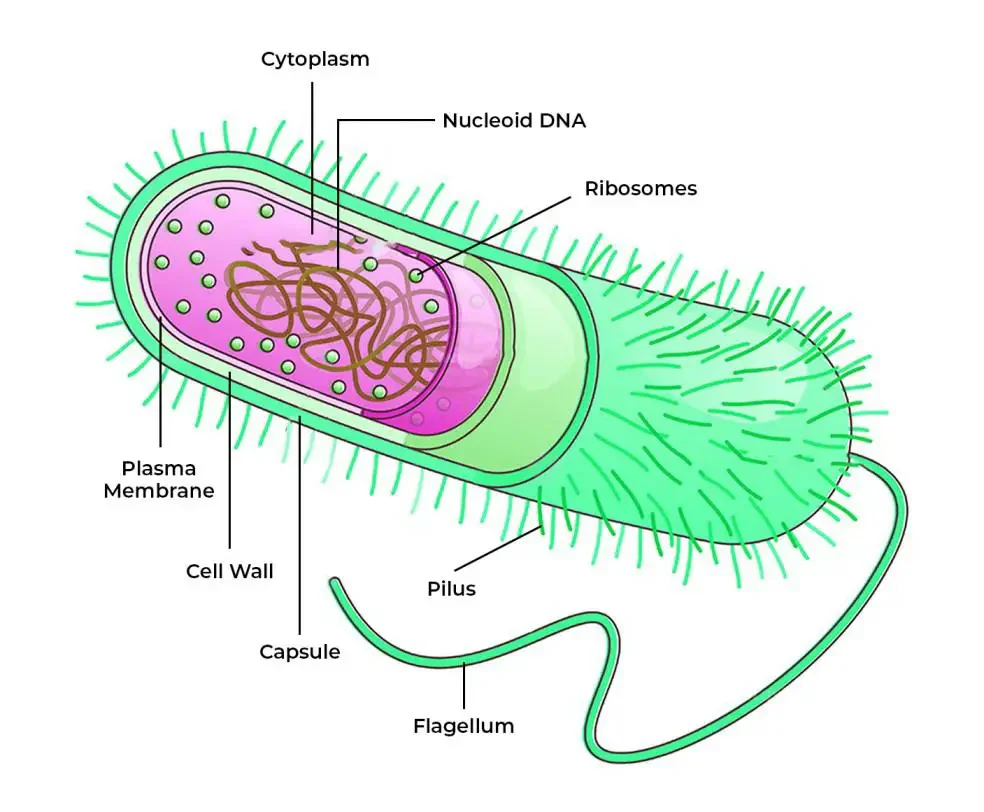
- Prokaryotic Cells
- Overview: Prokaryotic cells, encompassing bacteria and archaea, represent the earliest life forms on Earth. These cells are characterized by the absence of a defined nucleus and are generally smaller and simpler than their eukaryotic counterparts.
- Structural Features:
- Cell Envelope: Typically consists of a plasma membrane, often shielded by a cell wall and, in some cases, an additional capsule layer. This envelope provides structural support and acts as a protective barrier.
- Cytoplasmic Region: Houses the genome (DNA), ribosomes, and various inclusions. The DNA, though not enclosed within a nucleus, is organized in a region termed the nucleoid.
- Extrachromosomal Elements: Prokaryotes may possess plasmids, circular DNA fragments that encode supplementary genes.
- External Appendages: Structures like flagella and pili protrude from the cell surface, facilitating movement and intercellular communication.
- Morphological Diversity: Prokaryotic cells exhibit a range of shapes, including cocci (spherical), bacilli (rod-shaped), and spirochaetes (spiral).
- Eukaryotic Cells
- Overview: Eukaryotic cells, found in plants, animals, fungi, and certain protists, are characterized by the presence of a well-defined nucleus and membrane-bound organelles.
- Structural Features:
- Nucleus: A membrane-bound organelle that houses the cell’s DNA, organized into linear chromosomes associated with histone proteins.
- Membrane-Bound Organelles: Eukaryotic cells possess specialized compartments, such as mitochondria and chloroplasts, each with distinct functions. Some of these organelles also contain their own DNA.
- Cilia and Flagella: Eukaryotic cells may possess these structures for movement. Unlike prokaryotic flagella, eukaryotic flagella are structurally more intricate.
- Compartmentalization: A hallmark of eukaryotic cells is the presence of distinct organelles, facilitating specialized cellular activities in defined spaces.
In summary, the cellular world is marked by a dichotomy between prokaryotic and eukaryotic cells, each with its unique set of characteristics and functionalities. This classification underscores the evolutionary intricacies and the diverse strategies adopted by life forms to thrive in myriad environments.
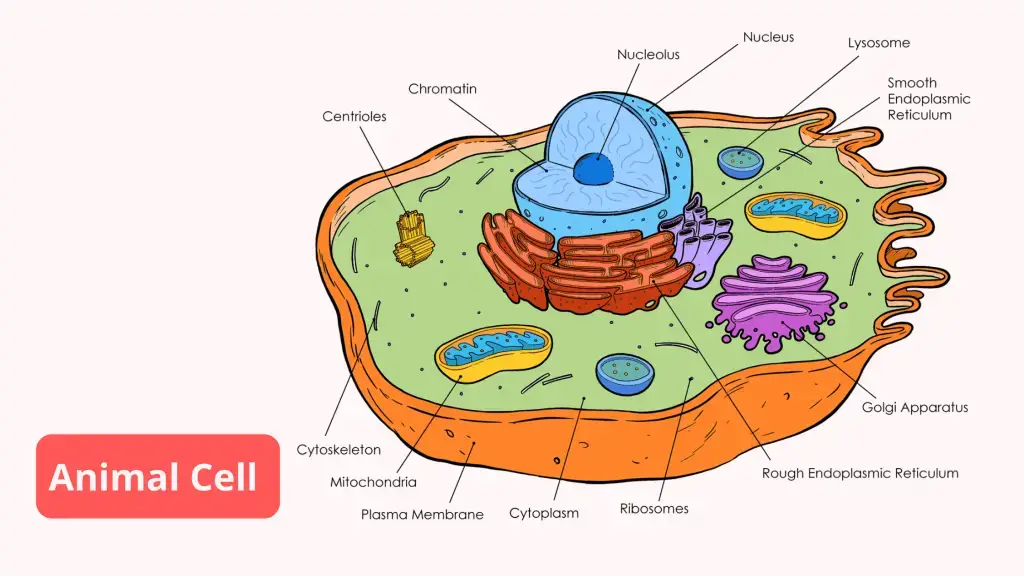
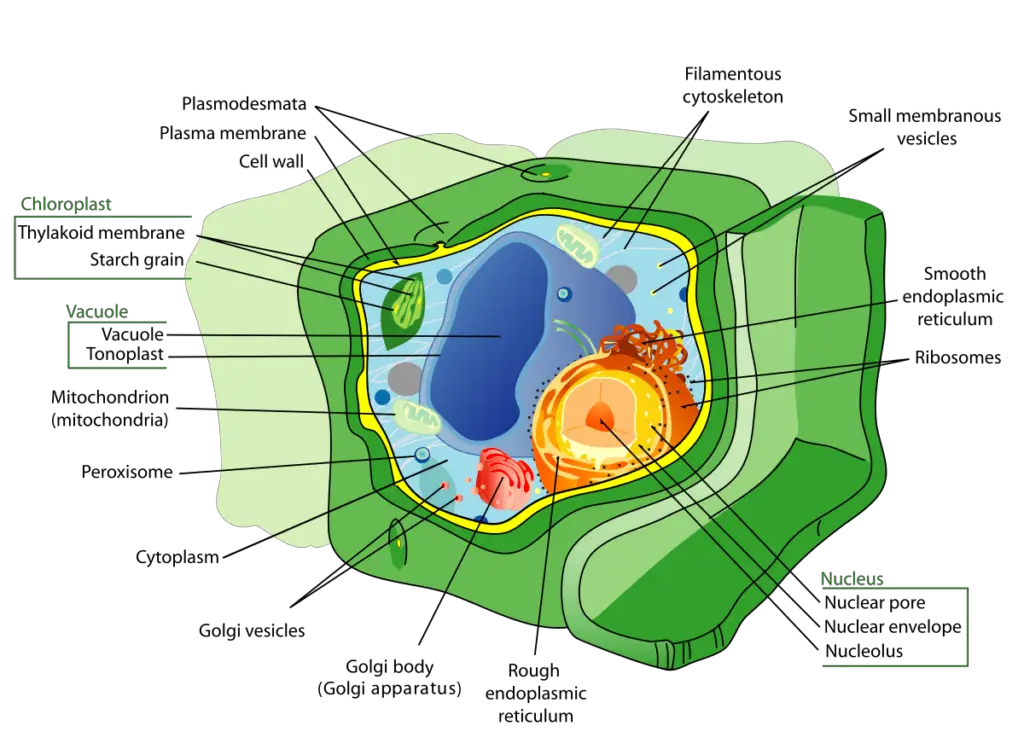
| Features | Prokaryotes | Eukaryotes |
|---|---|---|
| Typical Organisms | Bacteria, Archaea | Protists, Fungi, Plants, Animals |
| Size | Approximately 1–5 μm | Approximately 10–100 μm |
| Nucleus Type | Nucleoid region (lacks a true nucleus) | True nucleus enclosed by a double membrane |
| DNA Structure | Typically circular | Linear chromosomes associated with histone proteins |
| RNA/Protein Synthesis | Coupled in the cytoplasm | RNA synthesis occurs in the nucleus; protein synthesis takes place in the cytoplasm |
| Ribosomes | Comprise 50S and 30S subunits | Comprise 60S and 40S subunits |
| Cytoplasmic Structure | Minimal structures | Highly organized with endomembranes and a cytoskeleton |
| Cell Movement | Flagella composed of flagellin | Flagella and cilia with microtubules; lamellipodia and filopodia with actin |
| Mitochondria | Absent | Present, ranging from one to several thousand |
| Chloroplasts | Absent | Present in algae and plants |
| Organizational Structure | Typically unicellular | Unicellular, colonial, or multicellular with specialized cells |
| Cell Division | Binary fission | Mitosis (via fission or budding); meiosis |
| Chromosomes | Single chromosome | Multiple chromosomes |
| Membranes | Cell membrane only | Cell membrane, often accompanied by various organelle membranes |
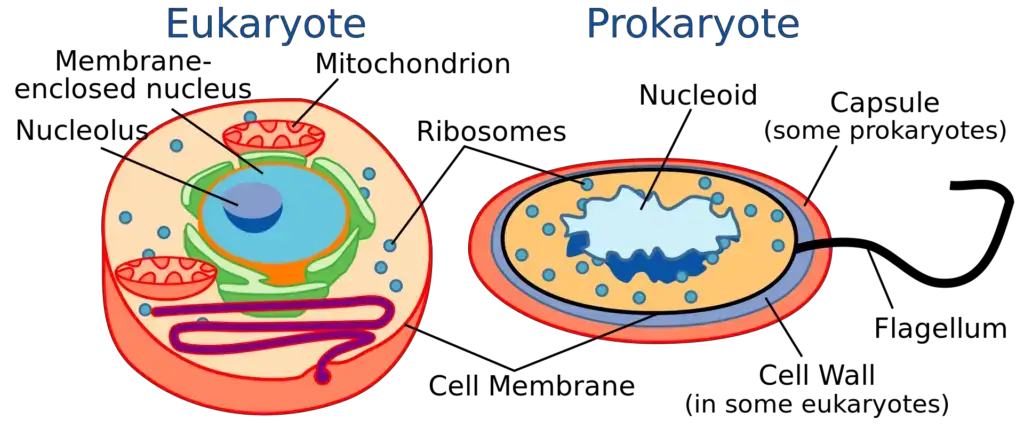
Cell Structure
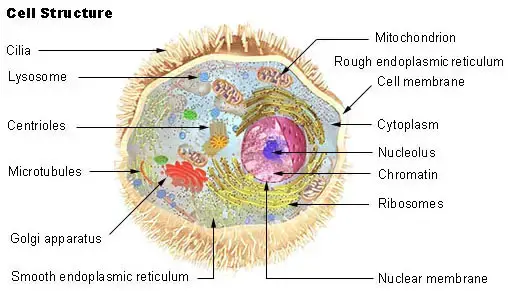
Cells, the foundational units of life, are intricately designed with specialized components, each playing a pivotal role in ensuring the cell’s functionality and vitality. Delving deeper into the cellular architecture, we identify the following key structural elements:
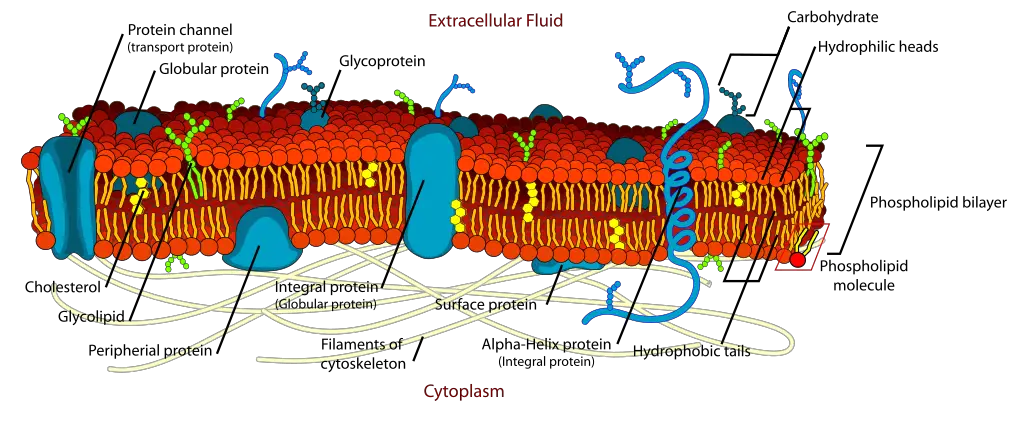
- Cell Membrane:
- Function: Serving as the cell’s protective barrier, the cell membrane regulates the ingress and egress of molecules, ensuring a controlled exchange with the external environment.
- Composition: Often termed the plasma membrane, this semi-permeable structure is equipped with selective pores, facilitating the movement of specific substances.
- Significance: Beyond its role in substance transport, the cell membrane provides structural integrity, safeguarding the cell’s internal components from potential harm and external fluctuations.
- Cell Wall:
- Distinctiveness: Exclusively found in plant cells, the cell wall is the outermost protective layer.
- Composition: Primarily constructed from cellulose, hemicellulose, and pectin, the cell wall exhibits rigidity and robustness.
- Function: This structural layer imparts shape, offers mechanical protection against external shocks, and provides additional support to the cell, fortifying its stance against environmental challenges.
- Cytoplasm:
- Description: Residing within the confines of the cell membrane, the cytoplasm is a viscous, gelatinous matrix.
- Role: Serving as the cellular arena, the cytoplasm hosts a myriad of biochemical reactions crucial for the cell’s sustenance.
- Inhabitants: Various cell organelles, including the endoplasmic reticulum, mitochondria, ribosomes, and vacuoles, are suspended within this matrix, orchestrating their respective functions.
- Nucleus:
- Genetic Repository: The nucleus houses the cell’s genetic blueprint, DNA, which dictates cellular activities and inheritance patterns.
- Regulatory Role: Acting as the cell’s command center, the nucleus governs cellular processes, directing growth, maturation, replication, and apoptosis.
- Structural Features: Encased within a nuclear envelope, the nucleus ensures the safeguarding of DNA, segregating it from the cytoplasmic milieu.
In essence, the cellular structure is a marvel of biological engineering, with each component synergistically contributing to the cell’s holistic function. This intricate design underscores the complexity and precision inherent in the realm of cellular biology.
Cell Organelles
Cellular organelles are intricate structures within cells that execute specific functions vital for the cell’s survival and operation. Analogous to the organs in multicellular organisms, each organelle has a distinct role, ensuring the cell’s optimal functioning.
Eukaryotic and prokaryotic cells both possess organelles. However, the organelles in prokaryotic cells are generally simpler and lack a surrounding membrane. The cellular matrix, known as the cytosol, is a gel-like substance that envelops these organelles.
Eukaryotic Organelles:
- Cell Nucleus: The nucleus, the cell’s command center, is the most prominent organelle in eukaryotic cells. It safeguards the cell’s genetic material and is the hub for DNA replication and RNA synthesis. Encased by the nuclear envelope, the nucleus ensures the DNA’s protection from potential external threats. Within the nucleus, the nucleolus is responsible for assembling ribosome subunits.
- Mitochondria and Chloroplasts: These organelles are pivotal for energy production. Mitochondria, present in all eukaryotic cells, facilitate aerobic respiration, converting nutrients into energy-rich ATP molecules. Chloroplasts, exclusive to plants and algae, harness sunlight to produce carbohydrates via photosynthesis.
- Endoplasmic Reticulum (ER): The ER is a cellular highway, directing molecules to their destinations. It exists in two forms: the ribosome-studded rough ER and the ribosome-free smooth ER, which plays a role in lipid synthesis and calcium regulation.
- Golgi Apparatus: This organelle processes and packages macromolecules like proteins and lipids synthesized by the cell.
- Lysosomes and Peroxisomes: Lysosomes house enzymes that break down waste materials and cellular debris. Peroxisomes neutralize toxic peroxides, ensuring cellular safety.
- Centrosome: Integral for cytoskeleton organization, the centrosome produces microtubules and oversees transport within the ER and Golgi apparatus.
- Vacuoles: These membrane-bound sacs isolate waste and, in plants, store water. They play a crucial role in maintaining cellular homeostasis.
Eukaryotic and Prokaryotic Organelles:
- Ribosomes: Comprising RNA and protein complexes, ribosomes are the cellular machinery where protein synthesis occurs using RNA templates.
- Plastids: Found predominantly in plant cells, plastids are membrane-bound organelles containing specific pigments. They can be classified into chloroplasts (involved in photosynthesis), chromoplasts (involved in pigment synthesis and storage), and leucoplasts (involved in nutrient storage).
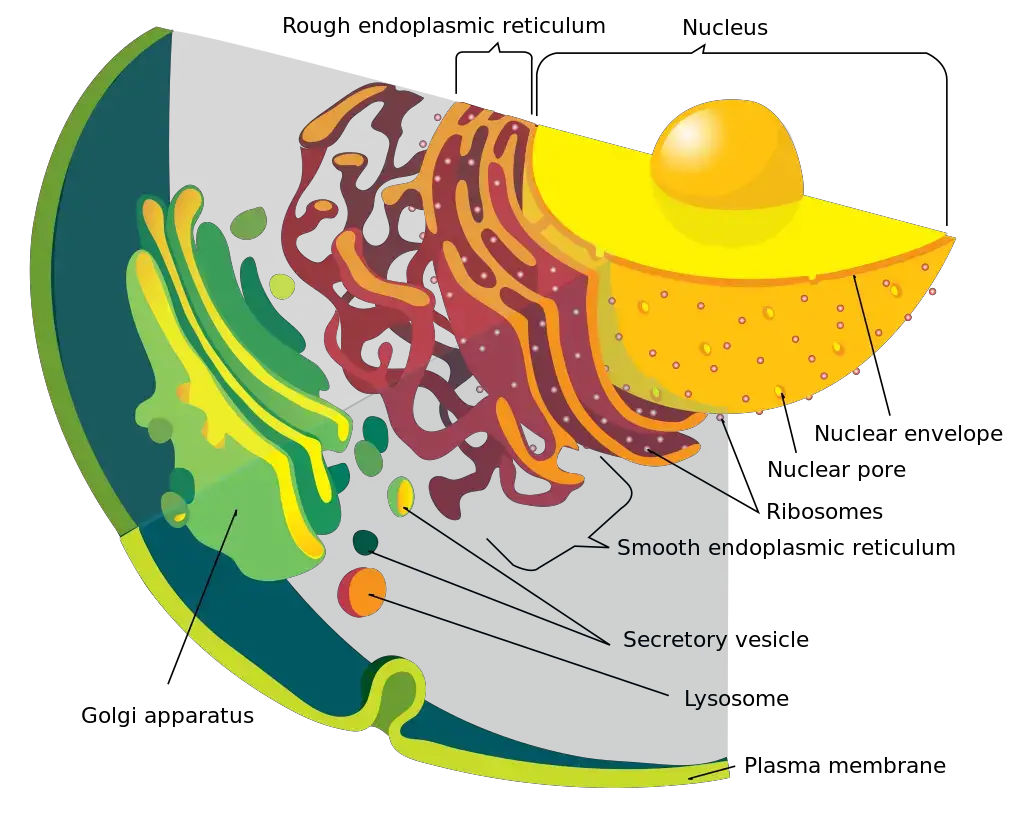
| Organelle | Function | Description |
|---|---|---|
| Nucleolus | Ribosome Synthesis | Central site for ribosome production and plays a role in cellular activities and reproduction. |
| Nuclear Membrane | Nucleus Protection | A double-layered boundary that safeguards the nucleus from the rest of the cell’s components. |
| Chromosomes | Genetic Information Storage | Essential for determining an individual’s traits. Each human cell contains 23 chromosome pairs. |
| Endoplasmic Reticulum (ER) | Substance Transportation | A network aiding in substance transport. The rough ER has ribosomes for protein synthesis, while the smooth ER assists in lipid synthesis and metabolism. |
| Golgi Apparatus | Macromolecule Processing | Modifies and packages proteins and lipids synthesized by the cell. |
| Mitochondria | Energy Production | Termed the “cell’s powerhouse,” it produces ATP, the cell’s energy currency, through oxidative phosphorylation. |
| Chloroplasts | Photosynthesis | Present in plants and algae, these organelles harness sunlight to produce carbohydrates. |
| Lysosomes | Waste Management | Contain enzymes to break down waste materials and foreign invaders. |
| Peroxisomes | Toxin Breakdown | Contain enzymes that neutralize toxins, especially peroxides. |
| Centrosome | Cytoskeleton Organization | Produces microtubules, essential for the cytoskeleton, and directs transport through the ER and Golgi apparatus. |
| Vacuoles | Storage | Store nutrients, waste products, and water. In plants, they also maintain turgor pressure. |
| Ribosomes | Protein Synthesis | Complexes of RNA and protein where protein synthesis occurs. |
| Plastids | Pigment Storage & Energy Capture | Membrane-bound organelles in plants and euglenoids. They store pigments and participate in photosynthesis. Types include chloroplasts (for photosynthesis), chromoplasts (pigment synthesis and storage), and leucoplasts (nutrient storage). |
Structures outside the cell membrane
Cells, the fundamental units of life, often possess structures that extend beyond the confines of the cell membrane. These extracellular structures are exposed to the external milieu, lacking the protective shield of the semipermeable cell membrane. The assembly of these structures necessitates the transportation of their components across the cell membrane via specialized export mechanisms.
Cell Wall: The cell wall is a prominent extracellular structure found in numerous prokaryotic and eukaryotic cells. It serves as a protective barrier, offering mechanical and chemical defense against external threats, complementing the protective role of the cell membrane. The composition of the cell wall varies among different cell types. While plant cells predominantly contain cellulose-based cell walls, fungal cells have walls composed of chitin, and bacterial cell walls are primarily constituted of peptidoglycan.
Prokaryotic Extracellular Structures:
- Capsule: Certain bacteria are enveloped by a gelatinous capsule that lies outside the cell membrane and cell wall. The composition of the capsule can vary, with some being made of polysaccharides, as seen in pneumococci and meningococci, while others, like Bacillus anthracis, have polypeptide capsules. Some even possess hyaluronic acid-based capsules, such as streptococci. These capsules are not readily stained using conventional methods but can be visualized using techniques involving India ink or methyl blue, enhancing the contrast for observation.
- Flagella: Flagella are whip-like structures that bestow motility to cells. In bacteria, the flagellum originates from the cytoplasm, traverses the cell membrane(s), and protrudes through the cell wall. These proteinaceous appendages are thick and elongated. It’s worth noting that archaea possess a distinct type of flagellum, while eukaryotes have yet another variant.
- Fimbriae (Pili): Fimbriae, also termed pili, are slender, hair-like projections on bacterial surfaces. Composed of the protein pilin, fimbriae facilitate bacterial attachment to specific receptors on host cells, mediating cell adhesion. Certain specialized pili play a role in bacterial conjugation, a process of genetic material transfer.
Cellular processes
The intricate machinery of life operates at the cellular level, where a plethora of processes ensures the sustenance, growth, and reproduction of organisms. These cellular processes are governed by complex biochemical reactions and pathways, ensuring the cell’s proper function and survival. Here, we delve into the fundamental cellular processes that dictate the life of a cell:
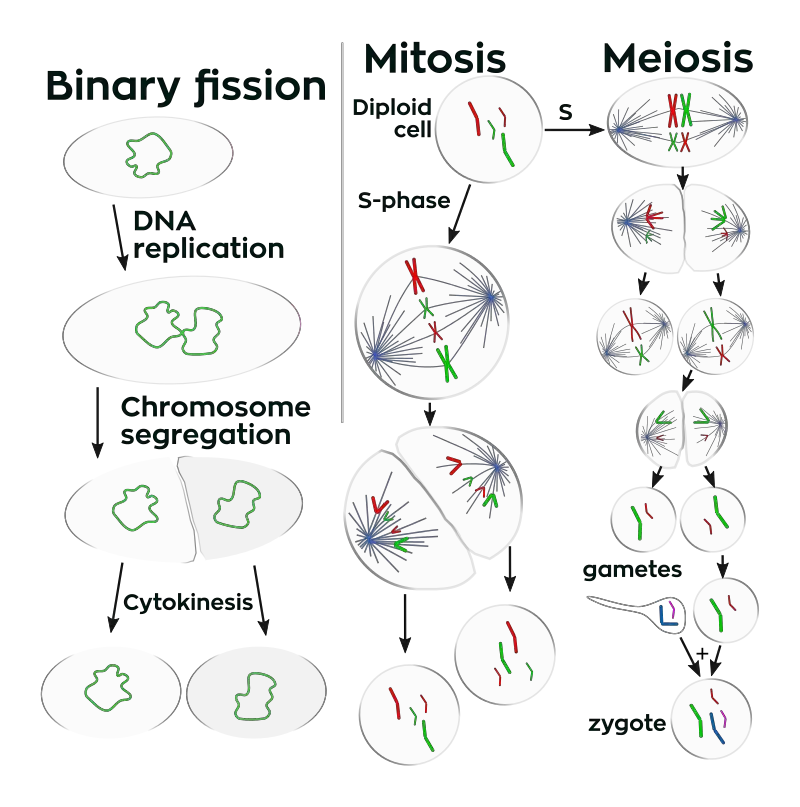
- Replication and Cell Division: Cells reproduce by dividing, a process essential for growth in multicellular organisms and for reproduction in unicellular entities. Prokaryotic cells undergo binary fission, while eukaryotic cells partake in mitosis, followed by cytokinesis. In certain scenarios, a diploid cell undergoes meiosis to produce haploid cells, which act as gametes in multicellular organisms.
- DNA Replication: Before cell division, a cell’s genome is duplicated. This ensures that the daughter cells inherit the complete set of genetic information. DNA replication is a meticulously regulated process, requiring specialized proteins for its execution.
- DNA Repair: Cells possess enzyme systems that continuously monitor and repair DNA damage. The presence of diverse repair mechanisms, such as nucleotide excision repair and recombinational repair, underscores the importance of maintaining DNA integrity.
- Growth and Metabolism: Cellular metabolism encompasses the biochemical reactions that facilitate cell growth. It is bifurcated into catabolism, where complex molecules are broken down, and anabolism, where complex molecules are synthesized. For instance, glucose is metabolized to produce adenosine triphosphate (ATP), a molecule central to cellular energy.
- Protein Synthesis: Proteins, the workhorses of the cell, are synthesized based on the genetic information encoded in DNA. This synthesis involves two primary steps: transcription, where DNA is transcribed into RNA, and translation, where RNA is translated into proteins. The entire process ensures the accurate translation of genetic information into functional protein molecules.
- Motility: Cellular movement is vital for various processes, from unicellular organisms seeking nutrients to multicellular entities repairing wounds. Mechanisms like flagella and cilia facilitate movement in unicellular organisms, while complex processes drive movement in multicellular organisms, such as during wound healing or immune responses.
- Navigation, Control, and Communication: Cells exhibit remarkable navigation capabilities, as evidenced by their ability to efficiently traverse complex environments. For instance, certain cells can generate gradients to sense and navigate through mazes, highlighting their sophisticated sensing and communication mechanisms.

Multicellularity Organism
Multicellularity, a hallmark of advanced life forms, refers to organisms composed of multiple cells, distinguishing them from unicellular entities. This intricate organization has paved the way for the emergence of diverse life forms with specialized functions and structures.
- Cellular Differentiation and Specialization: Multicellular organisms exhibit cellular differentiation, where genetically identical cells evolve into distinct cell types tailored for specific roles. For instance, mammals boast a plethora of cell types, including neurons, muscle cells, blood cells, and skin cells, to name a few. Despite sharing the same genetic makeup, these cells manifest different functions and appearances due to the differential gene expression they undergo.
- Genesis of Multicellularity: The phenomenon of multicellularity is not exclusive to eukaryotes; it has independently emerged at least 25 times across the evolutionary timeline, encompassing certain prokaryotes like cyanobacteria and myxobacteria. However, the intricate multicellular structures are predominantly observed in six eukaryotic groups: animals, fungi, brown algae, red algae, green algae, and plants. The origins of multicellularity can be traced back to various evolutionary pathways, including the formation of interdependent cellular colonies, cellularization, or symbiotic associations between organisms.
- Historical Evidence: The primordial evidence of multicellularity is found in cyanobacteria-like fossils dating back between 3 to 3.5 billion years. Other ancient multicellular remnants include the debated Grypania spiralis and the fossils discovered in the Palaeoproterozoic Francevillian Group Fossil B Formation in Gabon.
- Evolutionary Experiments: The transition from unicellularity to multicellularity has been recreated in controlled laboratory settings. Through evolutionary experiments, predation was employed as a selective pressure, leading to the emergence of multicellularity from unicellular progenitors.
In conclusion, multicellularity represents a significant evolutionary leap, allowing for the diversification and specialization of life forms. This complex organization has enabled organisms to adapt and thrive in varied environments, showcasing the marvels of evolutionary biology.
Cell Theory
The Cell Theory, a foundational tenet of biology, was pioneered by eminent German researchers: Theodor Schwann, Matthias Schleiden, and Rudolf Virchow. This theory elucidates the fundamental principles governing cellular biology and is summarized as follows:
- Universality of Cells: Every living organism, irrespective of its complexity, is constituted by cells.
- Fundamental Life Unit: Cells represent the quintessential structural and functional units that orchestrate the myriad processes vital for life.
- Cellular Lineage: New cells are not spontaneously generated; they emerge from the division of pre-existing cells.
In light of advancing scientific knowledge, the Cell Theory has been refined and expanded to encompass additional principles:
- Cellular Energetics: Cells are dynamic entities wherein energy is continuously channeled to drive various biochemical reactions.
- Genetic Continuity: Cells ensure the perpetuation of genetic information by transmitting it during cell division.
- Biochemical Uniformity: Despite the vast diversity of life, there exists a remarkable consistency in the chemical constituents of cells across all species.
Functions of Cell
Cells, the fundamental units of life, execute a myriad of functions pivotal for the sustenance, growth, and development of organisms. Herein, we delineate the principal roles undertaken by cells:
- Structural Foundation: Cells are the building blocks of all living entities. They confer structural integrity to organisms. Key cellular components, such as the cell wall and cell membrane, bestow support and form to organisms. For instance, human skin comprises myriad cells, while in vascular plants, the xylem, composed of specialized cells, imparts structural robustness.
- Growth through Cellular Division: Cells proliferate through a process known as mitosis, wherein a parent cell bifurcates into two offspring cells. This cellular multiplication underpins growth in organisms.
- Substance Transport Mechanisms: Cells orchestrate the import of essential nutrients required for intracellular biochemical reactions. Concurrently, they expel waste products generated from these reactions. Molecular transport across the cell membrane can be:
- Passive Transport: Small molecules like oxygen and carbon dioxide traverse the cell membrane via diffusion, moving along their concentration gradients.
- Active Transport: Larger molecules necessitate significant energy for their transport across the cell membrane, a process facilitated by cellular energy.
- Energy Generation: To fuel their myriad activities, cells necessitate energy. This energy is harnessed through photosynthesis in plants and cellular respiration in animals.
- Role in Reproduction: Cells play an instrumental role in organismal reproduction. They undergo mitosis, a form of asexual reproduction, where a parent cell divides to yield identical daughter cells. Conversely, meiosis results in daughter cells that are genetically distinct from their parent, ensuring genetic diversity.
- Synthesis of Biomolecules: Cells are the sites for the synthesis of vital biomolecules, including proteins, nucleic acids, lipids, and carbohydrates. The ribosomes, endoplasmic reticulum, and Golgi apparatus work in tandem to ensure the synthesis, modification, and transport of proteins.
- Cellular Communication: Cells communicate with each other through signaling pathways. This communication is crucial for processes like tissue repair, immune responses, and coordination of activities in multicellular organisms.
- Homeostasis: Cells maintain a stable internal environment, ensuring that pH, temperature, and nutrient concentrations are optimal for cellular activities.
- Waste Management: Lysosomes and peroxisomes in cells break down waste materials and toxins, ensuring that the cell remains unpolluted and functional.
- Defense and Immunity: Certain cells, especially in animals, play a role in defending the organism against pathogens. White blood cells, for instance, are involved in identifying and destroying foreign invaders.
- Cell Differentiation: Stem cells have the ability to differentiate into various specialized cell types, ensuring that organisms can develop specialized tissues and organs.
- Genetic Inheritance: Cells house the genetic material (DNA) that is passed from one generation to the next. This ensures the continuity of genetic traits and the propagation of species.
- Cell Motility: Some cells, like sperm cells in animals and certain bacteria, exhibit motility. They possess structures like flagella or cilia that enable movement.
- Storage: Vacuoles in plant cells store nutrients, waste products, and help in maintaining turgor pressure. Similarly, fat cells in animals store lipids that can be used as an energy reserve.
- Sensory Functions: Certain cells, especially in higher animals, are specialized to detect changes in the environment. For instance, photoreceptor cells in the eyes detect light, while olfactory cells in the nose detect odors.
In essence, cells are dynamic entities that not only provide structure but also drive growth, facilitate transport, generate energy, and play a pivotal role in reproduction, underscoring their indispensable nature in the realm of biology.
Examples of Cell
Cells are the basic building blocks of all living organisms. Here are examples of different types of cells:
- Prokaryotic Cells:
- Bacterial Cells: These are simple cells without a nucleus. Examples include Escherichia coli (E. coli) and Staphylococcus aureus.
- Eukaryotic Cells:
- Animal Cells:
- Red Blood Cells (Erythrocytes): These cells transport oxygen throughout the body.
- Neurons: These are nerve cells responsible for transmitting electrical signals.
- Muscle Cells: These cells are responsible for movement. Examples include skeletal muscle cells, cardiac muscle cells, and smooth muscle cells.
- Sperm Cells: Male reproductive cells.
- Ovum (Egg Cell): Female reproductive cell.
- Plant Cells:
- Leaf Cells (Mesophyll Cells): These cells contain chloroplasts and are responsible for photosynthesis.
- Root Hair Cells: Specialized for nutrient uptake from the soil.
- Guard Cells: These cells surround the stomata and regulate the opening and closing of the stomata to control gas exchange.
- Fungal Cells:
- Yeast Cells: Single-celled fungi used in baking and brewing.
- Mycelium Cells: These make up the body of multicellular fungi like mushrooms.
- Protist Cells:
- Amoeba: A single-celled organism that moves using pseudopods.
- Paramecium: A single-celled, ciliated protist.
- Euglena: A single-celled organism with characteristics of both plants (has chloroplasts) and animals (can move).
- Animal Cells:
- Specialized Cells:
- White Blood Cells (Leukocytes): Part of the immune system and help fight infections.
- Platelets: Involved in blood clotting.
- Epithelial Cells: These cells line the surfaces of organs and structures in the body.
- Adipocytes: Fat storage cells.
- Osteocytes: Bone cells.
History of research on Cell
The study of cells, the fundamental units of life, has undergone a remarkable transformation over the centuries. This journey, marked by groundbreaking discoveries and technological advancements, has shaped our understanding of the biological world.
- The Dawn of Microscopy (1632-1723): Antonie van Leeuwenhoek, a self-taught lens maker, pioneered the construction of rudimentary optical microscopes. His meticulous observations led to the documentation of protozoa, like Vorticella from rainwater, and even bacteria from his oral cavity.
- The Coining of “Cell” (1665): Robert Hooke’s exploration of cork and living plant tissue under an early compound microscope revealed tiny structures reminiscent of small rooms. This observation culminated in him introducing the term “cell”, derived from the Latin word ‘cellula’, in his seminal work, “Micrographia”.
- Birth of the Cell Theory (1839): Theodor Schwann and Matthias Jakob Schleiden, through their collaborative efforts, recognized the universal presence of cells in both plants and animals. Their assertion that cells are the foundational unit of structure and development gave rise to the cell theory.
- The Continuity of Cells (1855): Rudolf Virchow, building on the cell theory, posited that all cells arise from pre-existing cells through the process of cell division, encapsulated in the phrase “omnis cellula ex cellula”.
- Debunking Spontaneous Generation (1859): The age-old belief in spontaneous generation, the idea that life could spontaneously arise from non-living matter, faced a significant challenge. Louis Pasteur, building on the earlier work of Francesco Redi, presented evidence against this notion.
- Electron Microscopy Revolution (1931): Ernst Ruska’s invention of the transmission electron microscope at the University of Berlin marked a turning point in cell research. By 1935, he had enhanced the microscope’s resolution twofold, unveiling cellular organelles previously hidden from view.
- Unraveling the DNA Double Helix (1953): Building on Rosalind Franklin’s foundational work, James Watson and Francis Crick unveiled the double helix structure of DNA, a discovery that would revolutionize molecular biology.
- Endosymbiotic Theory (1981): Lynn Margulis, in her publication “Symbiosis in Cell Evolution”, presented the endosymbiotic theory. This theory proposed that certain organelles within eukaryotic cells, such as mitochondria and chloroplasts, originated from ancient symbiotic bacteria.
Here are some recent advancements in cell research:
- ISSCR Guidelines for Stem Cell Research and Clinical Translation: The 2021 update
- Publication Date: 2021-05-25
- Authors: R. Lovell-Badge, Eric Anthony, R. Barker, and others.
- Abstract: The International Society for Stem Cell Research updated its Guidelines for Stem Cell Research and Clinical Translation to address the advances in stem cell science and associated ethical, social, and policy issues since the last update in 2016. The guidelines serve as the standard for the field, assisting scientists, regulators, funders, physicians, and the public.
- Read the full paper
- Advances in stem cell research and therapeutic development
- Publication Date: 2019-07-01
- Authors: M. De Luca, A. Aiuti, G. Cossu, M. Parmar, G. Pellegrini, P. Robey.
- Abstract: This review surveys key advancements in stem cell research and describes the cell types currently being used in the clinic or nearing clinical trials. The authors analyze the scientific rationale, experimental approaches, and results underpinning the clinical use of such stem cells.
- Read the full paper
- Animal mesenchymal stem cell research in cartilage regenerative medicine – a review
- Publication Date: 2019-01-01
- Authors: M. B. Gugjoo, M. Fazili, M. A. Gayas, R. A. Ahmad, K. Dhama.
- Abstract: This review discusses the potential of regenerative medicine involving stem cells for cartilage repair. The authors focus on the use of mesenchymal stem cells (MSCs) for articular cartilage repair in animal species, highlighting the achievements and limitations associated with their use.
- Read the full paper
- Therapeutic abortion and ectopic pregnancy: alternative sources for fetal stem cell research and therapy in Iran as an Islamic country
- Publication Date: 2018-12-07
- Authors: P. Goodarzi, Khadijeh Falahzadeh, H. Aghayan, and others.
- Abstract: This paper discusses the challenges of using fetal stem cells for research and therapy in Islamic countries like Iran. The authors suggest the utilization of ectopic pregnancy conceptus and extra-embryonic tissues as potential sources for embryonic or fetal stem cell isolation.
- Read the full paper
- Progress in Circulating Tumor Cell Research Using Microfluidic Devices
- Authors: Hogyeong Gwak, Junmoo Kim, Leila Kashefi-Kheyrabadi, B. Kwak, Kyung-A Hyun, H. Jung
- Publication Date: July 2018
- Abstract: The study focuses on circulating tumor cells (CTCs) which have become a significant topic in cancer research due to their obtainability through liquid biopsy, a minimally invasive procedure. The research has delved into CTC enumeration, profiling, and the correlation between CTC number and patient survival. The paper reviews the trends in isolating and analyzing CTCs using microfluidics, emphasizing the advantages of continuous sample processing and the potential of “do-everything-on-a-chip” approach. The study also touches upon the heterogeneity of tumor cells and the importance of single-CTC analysis after isolation.
- Read the full paper
- Recent Advances in CD8+ Regulatory T Cell Research
- Authors: Yating Yu, Xinbo Ma, R. Gong, Jian-Yang Zhu, Lihua Wei, Jinguang Yao
- Publication Date: June 2018
- Abstract: The paper delves into the roles of CD8+ T lymphocytes, particularly CD8+ regulatory T cells (CD8+ Tregs) which possess significant immunosuppressive functions. These cells play a crucial role in blocking overreacting immune responses and maintaining immune homeostasis. The study reviews the origin, functional classification, molecular markers, and mechanisms of action of CD8+ Tregs.
- Read the full paper
- Analysis of Trends and Emerging Technologies in Water Electrolysis Research Based on a Computational Method
- Authors: Takaya Ogawa, Mizutomo Takeuchi, Y. Kajikawa
- Publication Date: February 2018
- Abstract: The research focuses on water electrolysis for hydrogen production, a topic of increasing importance for accumulating renewable energy. The study provides a comprehensive review of all water electrolysis research areas through computational analysis, using a citation network to detect emerging technologies and forecast trends.
- Read the full paper
- Fake News Portrayals of Stem Cells and Stem Cell Research
- Authors: A. Marcon, Blake Murdoch, T. Caulfield
- Publication Date: October 2017
- Abstract: This study delves into how stem cells and stem cell research are portrayed on websites known for disseminating distorted and dubious information. The findings highlight the existence of organized misinformation networks which may mislead the public and polarize public discourse.
- Read the full paper
In summation, the trajectory of cell research has been marked by persistent inquiry, technological advancements, and paradigm-shifting discoveries. This historical tapestry underscores the relentless human endeavor to unravel the mysteries of the cellular world.

Quiz
What is the basic structural and functional unit of all living organisms?
a) Tissue
b) Organ
c) Cell
d) Organ system
Which organelle is known as the powerhouse of the cell?
a) Nucleus
b) Endoplasmic Reticulum
c) Mitochondria
d) Golgi Apparatus
Which type of cell lacks a nucleus?
a) Eukaryotic
b) Prokaryotic
c) Animal cell
d) Plant cell
The cell membrane is primarily composed of:
a) Proteins
b) Carbohydrates
c) Lipids
d) Nucleic acids
Which organelle is responsible for photosynthesis in plant cells?
a) Lysosome
b) Chloroplast
c) Ribosome
d) Vacuole
Which of the following is NOT found in animal cells?
a) Cell wall
b) Mitochondria
c) Lysosomes
d) Cytoplasm
The endoplasmic reticulum (ER) that has ribosomes attached to it is called:
a) Smooth ER
b) Rough ER
c) Granular ER
d) Non-granular ER
Which structure is responsible for regulating the transport of substances in and out of the cell?
a) Nuclear membrane
b) Cell wall
c) Cytoplasm
d) Cell membrane
Which organelle is responsible for breaking down waste materials in the cell?
a) Mitochondria
b) Ribosome
c) Lysosome
d) Nucleus
DNA is located in which part of the cell?
a) Mitochondria
b) Cytoplasm
c) Nucleus
d) Endoplasmic reticulum
FAQ
What is a cell?
A cell is the basic structural, functional, and biological unit of all known living organisms. It is the smallest unit of life that can replicate independently.
How many types of cells are there?
Broadly, there are two main types of cells: Prokaryotic (without a nucleus, like bacteria) and Eukaryotic (with a nucleus, like plant and animal cells).
What is the main difference between plant and animal cells?
While both plant and animal cells are eukaryotic, plant cells have a cell wall, chloroplasts, and a large central vacuole, which are absent in animal cells.
What is the function of the nucleus in a cell?
The nucleus acts as the control center of the cell, housing its DNA and directing the synthesis of proteins and ribosomes.
Why are cells so small?
Cells are small to maximize the surface area to volume ratio, which allows for efficient exchange of nutrients and waste materials.
What is the role of the mitochondria?
Often referred to as the “powerhouse” of the cell, mitochondria produce energy in the form of ATP through the process of cellular respiration.
How do cells reproduce?
Cells reproduce through processes called mitosis (for somatic cells) and meiosis (for reproductive cells or gametes).
What is the function of the cell membrane?
The cell membrane, also known as the plasma membrane, regulates the transport of substances in and out of the cell and provides protection and support.
What are stem cells and why are they important?
Stem cells are undifferentiated cells that have the potential to develop into many different cell types. They play a crucial role in development, repair, and regeneration in organisms.
How do cells communicate with each other?
Cells communicate through various mechanisms, including chemical signals (like hormones and neurotransmitters), direct cell-to-cell contact, and electrical signals.
References
- Biology Online. (n.d.). Cell. Retrieved from https://www.biologyonline.com/dictionary/cell
- BYJU’S. (n.d.). Cells. Retrieved from https://byjus.com/biology/cells/
- Wikipedia. (n.d.). Cell (biology). Retrieved from https://en.wikipedia.org/wiki/Cell_(biology)
- Vedantu. (n.d.). Cell structure and function. Retrieved from https://www.vedantu.com/biology/cell-structure-and-function
- Encyclopædia Britannica. (n.d.). Intercellular communication. Retrieved from https://www.britannica.com/science/cell-biology/Intercellular-communication
- SEER Training. (n.d.). Cell structure. Retrieved from https://training.seer.cancer.gov/anatomy/cells_tissues_membranes/cells/structure.html
- LibreTexts. (n.d.). Cell structure and function. Retrieved from https://med.libretexts.org/Bookshelves/Anatomy_and_Physiology/Human_Anatomy_and_Physiology_Preparatory_Course_(Liachovitzky)/04%3A_Smallest_Level_of_Complexity_Alive-_Cells_Their_Structures_and_Functions/4.01%3A_Cell_Structure_and_Function
- StudySmarter. (n.d.). Cell structure. Retrieved from https://www.studysmarter.co.uk/explanations/biology/cells/cell-structure/
- Osmosis. (n.d.). Cellular structure and function. Retrieved from https://www.osmosis.org/learn/Cellular_structure_and_function
- Career Launcher. (n.d.). CBSE cell structure and functions. Retrieved from https://www.careerlauncher.com/cbse-ncert/class-8/Science/CBSE-CellStructureandFunctions.html
- ThoughtCo. (n.d.). Types of cells in the body. Retrieved from https://www.thoughtco.com/types-of-cells-in-the-body-373388
- NCERT. (n.d.). Exemplar problems. Retrieved from https://ncert.nic.in/pdf/publication/exemplarproblem/classVIII/science/heep108.pdf
- NCERT. (n.d.). Science textbook. Retrieved from https://ncert.nic.in/textbook/pdf/hesc108.pdf
- Text Highlighting: Select any text in the post content to highlight it
- Text Annotation: Select text and add comments with annotations
- Comment Management: Edit or delete your own comments
- Highlight Management: Remove your own highlights
How to use: Simply select any text in the post content above, and you'll see annotation options. Login here or create an account to get started.